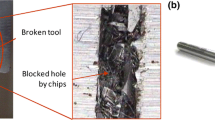Abstract
Drilling is a crucial cutting operation as it represents 40 to 60% of the total material removed in the aircraft frame industry. Drilling difficult-to-cut materials, such as Ti-6Al-4V, is still a challenge due to their high chemical reactivity with different tool materials and low thermal conductivity. The application of cooling approach is needed to reduce the generated cutting temperature at the machining area. However, in drilling, the coolant does not sufficiently reach to the drill tip at the cutting zone because of the counter flow of the chips limits further penetration, especially in deep-hole drilling. To overcome such problems during direct drilling, different drilling techniques are followed. Peck drilling is among these methods in which the drilling process is conducted in a number of steps to achieve holes with large aspect ratio. The current study presents a detailed comparison between direct drilling and peck drilling of Ti-6Al-4V in terms of tool life, surface roughness, thrust force, torque, and burr formation. In terms of flank wear, thrust force, and burr formation, peck drilling showed better results when compared to direct drilling; however, direct drilling offers slightly better results in terms of surface quality.












Similar content being viewed by others
References
Hegab H, Darras B, Kishawy HA (2018). Sustainability assessment of machining with nano-cutting fluids. Procedia Manufacturing 26:245–254
Hegab H, Kishawy H, (2018). Towards sustainable machining of Inconel 718 using nano-fluidminimum quantity lubrication. Journal of Manufacturing and Materials Processing 2(3):50.
Eltaggaz A, Hegab H, Deiab I, Kishawy HA (2018). Hybrid nano-fluidminimum quantity lubrication strategy for machining austempered ductile iron (ADI). Int J Interact Des Manuf 1–9
Eltaggaz A, Zawada P, Hegab HA, Deiab I, Kishawy, HA (2018). Coolant strategy influence on tool life and surface roughness when machining ADI. Int J Adv Manuf Technol 94(9–12):3875–3887
E Commission (2011) Flightpath 2050 Europe’s Vision for Aviation. European Union, Luxembourg
Bandapalli K, Singh M (2015) Sutaria and V. Bhat, experimental investigation of machinability parameters in high-speed micro-end milling of titanium (grade-2), International. Adv Manuf Technol 85:2139–2153
Pervaiz S, Rashid A, Deiab I, Nicolescu M (2014) Influence of tool materials on machinability of titanium- and nickel-based alloys: a review. Mater Manuf Process 29(3):219–252
Pervaiz S, Rashid A, Deiab I, Nicolescu C (2016) An experimental investigation on the effect of minimum quantity cooling lubrication (MQCL) in machining titanium alloy (Ti6Al4V). Int J Manuf Technol 87:1371–1386
Pramanik A (2014) Problems and solutions in machining of titanium alloys. Int J Adv Manuf Technol 70:919–928
Sharif S, Abd Rahim E (2007) Performance of coated-and uncoated-carbide tools when drilling titanium alloy-Ti6Al4V. J Mater Process Technol 185(1–3):72–76
Yip W, To S (2017) Tool life enhancement in dry diamond turning of titanium alloys using an eddy current damping and a magnetic field for sustainable manufacturing. J Clean Prod 168:929–939
Ezugwu E, Wang Z (1997) Titanium alloys and their machinability—a review. J Mater Process Technol 68:262–274
Mathew NT, Vijayaraghavan L (2016) Drilling of titanium aluminide at different aspect ratio under dry and wet conditions. J Manuf Process 24:256–269
Ravisubramanian S, Shunmugam MS (2018) Investigations into peck drilling process for large aspect ratio microholes in aluminum 6061-T6. Mater Manuf Process 33(9):935–942
Duck WK, Young SL, Min SP, Chong NC (2009) Tool life improvement by peck drilling and thrust force monitoring during deep-micro-hole drilling of steel. Int J Mach Tool Manu 49:246–255
Nakagawa H, Ogawa K, Kihara A, Hirogaki T (2007) Improvement of micro-drilled hole quality for printed wiring boards. J Mater Process Technol 191:293–296
Csala V, Szalay T, Farkas B, Markos S (2015) Application benchmark of three micro hole machining processes for manufacturing the nozzle of a medical water jet machine. Acta Polytech Hung 12(2):53–69
Bagci E, Ozcelik B (2006) Investigation of the effect of drilling condition on the twist drill temperature during step-by-step and continuous dry drilling. Mater Des 27:446–454
Abdelhafeez AM, Soo SL, Aspinwall DK, Dowson A, Arnold D (2015) Burr formation and hole quality when drilling titanium and aluminum alloys. Procedia CIRP 37:230–235
Ko S-L, Chang J-E, Yang G-E (2003) Burr minimizing scheme in drilling. J Mater Process Technol 140(1–3):237–242
Abele E, Elsenheimer J, Hohenstein J, Tschannerl M (2005) Influence of drill dynamics on bore quality. CIRP Ann Manuf Technol 54:83–86
T C & G. F. CORPORATION (2017) [Online]. Available: http://pdocs.masterchemical.com/mcc/docs/db-docs/pdf_di/MicroSol_690XT.pdf. [Accessed 4 Jan 2019]
Muthukrishnan N, Davim P (2011) Influence of coolant in machinability of titanium alloy (Ti-6Al-4V). Journal of Surface Engineered Materials and Advanced Technology 1(1):9–14. https://doi.org/10.4236/jsemat.2011.11002. Accessed April 2011
Dolinsek S, Sustarsic B, Kopac J (2001) Wear mechanism of cutting tools in high speed cutting process. Wear 250:349–352
Ozden I, Elaheh G (2013) Comparative study of tool life and hole quality in drilling of CFRP/titanium stack using coated carbide drill. Mach Sci Technol 17:380–409
Mathew N, Vijayaraghavan L (2017) Environmentally friendly drilling of intermetallic titanium aluminide at different aspect ratio. J Clean Prod 141:439–452
Pervaiz S, Rashid A I. Deiab and M Nicolescu
Aurich J, Dornfeld D, Arrazola P, Frank V, Leitz L, Min S (2009) Burrs-analysis, control and removal, CIRP Annual- MAnufacture. Technology 58(2)
Ozden I, Elaheh G (2013) Comparative study of tool life and hole quality in drilling of CFRPcfrp/titanium stack using coated carbide drill. Mach Sci Technol 17(3):380–409
Acknowledgments
The authors acknowledge the support of the Natural Sciences and Engineering Research Council of Canada (NSERC) and the Ontario Centers of Excellence (OCE).
Author information
Authors and Affiliations
Corresponding author
Additional information
Publisher’s note
Springer Nature remains neutral with regard to jurisdictional claims in published maps and institutional affiliations.
Rights and permissions
About this article
Cite this article
Eltaggaz, A., Deiab, I. Comparison of between direct and peck drilling for large aspect ratio in Ti-6Al-4V alloy. Int J Adv Manuf Technol 102, 2797–2805 (2019). https://doi.org/10.1007/s00170-019-03314-z
Received:
Accepted:
Published:
Issue Date:
DOI: https://doi.org/10.1007/s00170-019-03314-z



